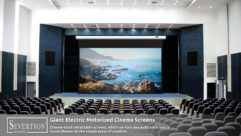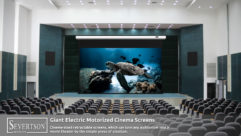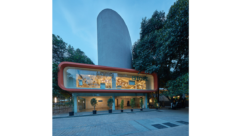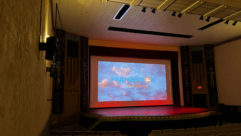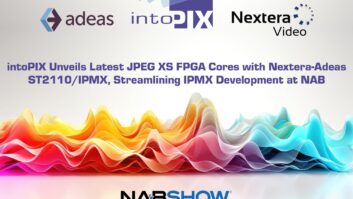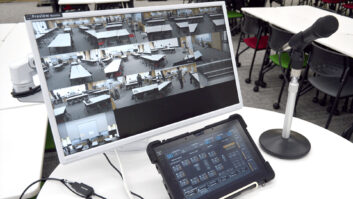
Multipurpose Museum
Jun 1, 2012 4:01 PM,
By Cynthia Wisehart
How installed AV systems support event revenue

In the Robert H. and Clarice Smith New York Gallery of American History at the New-York Historical Society Museum & Library, guests are dressed in smart business attire mingle, sipping cocktails and snacking from a good quality buffet. You overhear people saying to each other, “You know, I always meant to come here. … I had no idea this was such a nice museum. … Did you see the movie?” Occasionally someone rejoins their colleagues and apologizes for wandering off, distracted by the minutiae of Manhattan’s past. Directly across from the bar, a few guests try out the large interactive exhibit—with big metal handles they aim each of five rotating touchscreens at a wall of art and artifacts, zooming in on various pieces to view detailed information. Other visitors congregate throughout the hall on benches or in corners, deep in conversation.
We’re in New York’s oldest museum, on the upper west side; Central Park is directly across the street. You couldn’t pay an interior designer for the decor—priceless artifacts of New York history, displayed with a blend of sleek high tech elegance and 19th century architecture. The museum’s three-year, $70 million renovation—by Platt Byard Dovell White Architects and Lee H. Skolnick Architecture + Design Partnership—transformed a warren of small, bookish dens of antiquity into an open, modern space, a welcoming entry to the four-story building that houses some of New York’s most precious memories. Since it reopened last November, visitors experience multimedia displays from filmmaker Donna Lawrence and design firms Unified Field in New York and Small Design Firm in Cambridge, Massachusetts, and attend what is already a sizeable roster of special events; it’s all supported with a building-wide AV system designed and installed by Electrosonic.
In the process of the renovation, the New-York Historical Society Museum has not just become a 21st century museum but also a competitive events venue. The director of special events, Alex Maresca, came from the American Museum of Natural History event department last fall. Jason Licht, AV technical director, joined about a year ago with a background in multipurpose venue; he supports the AV systems, which are integral to the event offering.
Part of what makes the New-York Historical Society Museum such an attractive event venue is the variety of spaces and the opportunity to plan events that move among one or more of these spaces. Distributed audio and portable AV contribute to this flexibility, allowing organizations to host a presentation in the theater and then adjourn to the largest hall for a reception—where overflow crowds could hear and see the theater presentation remotely.
The environment lends itself to events from small boardroom-style business meetings to galas; the downstairs floor is the only children’s history museum and library in the city. A recent Bloomberg event demonstrated how the Smith Gallery could be transformed into a nightclub-style space. “The organizers reprogrammed the lighting and the audio and really turned it into an experience,” Licht points out. “Having a flexible installed systems is a draw.
“When I tell them they can change the video on the big entry columns, that makes an impression,” Maresca adds, especially for corporate people who may want to brand their event. “People want to know how they can personalize a space.” At the same time, she says, they want the benefit of the museum’s atmosphere and capabilities.
The upscale and dynamic tone of the venue is set immediately upon entering. Just before the admissions counter, guests encounter an interactive “living painting,” by Small Design Firm. A simulation of a painting from the museum’s collection—“Pulling Down the Statue of King George III” by Johannes A.S. Oertel—is displayed on a 2’x5’ landscape-oriented videowall made up of 10 narrow-mullion Planar Matrix 55in. monitors. At first glance the painting on the videowall appears to be just that: a static painting. But behind the monitors, Dell computers run an application that makes the picture come alive. Using a Microsoft Kinect camera, which tracks the movement of visitors, the computers begin to change the content of the painting—first subtly and then, as a crowd gathers, with increasing visibility. Initially, visitors hear the faint crackling and burning sound of the fire in the painting. When they approach the monitors, the dog in the foreground starts to move—or does it? As more visitors gather in front of the videowall, and the longer they remain, the painting grows livelier, the action more obvious. Soon the Revolutionary War colonists begin to tug on the ropes around the man-on-horseback statue in the mid-ground, and sounds of their struggle increase, as it crashes to the ground in a cloud of smoke and ash. With that the painting returns to its original state.
This initial exhibit exemplifies the atmosphere of the museum: It’s reverent and dynamic at once. A few steps further on, Skolnick’s design for the admissions desk incorporates digital signage cases of striking, semi-mirrored ad notam glass, built by DCL in Boston and providing visitors with information about the museum’s offerings and activities. With the help of AV consultant TAD, Electrosonic supplied C-nario signage software and players, which Unified Field used to craft the signage content.
Two things strike me as I tour the public spaces and behind-the-scenes with Electrosonic’s Project Manager, Ellen Simich. First: This is something that many museums could in theory do. There are a variety of galleries that lend themselves to a wide range of gatherings, and it seems a big improvement over an impersonal hotel. The other thing I notice is the AV systems have been tucked into cloakrooms, behind walls, used wirelessly—much of this to accommodate the challenges that go with a refit in an historical building. Some of the AV exhibits operate as standalone exhibits, yet a remarkable amount of the museum is networked across multiple floors.
Multipurpose Museum
Jun 1, 2012 4:01 PM,
By Cynthia Wisehart
How installed AV systems support event revenue

This multipurpose Robert H. Smith Auditorium, expanded with a mezzanine floor to greatly increase its capacity, hosts presentations in the form of a distinguished speaker series and other public programs and performances in the evenings. During the day, the same space showcases an 18-minute multi-screen media experience titled New York Story.
One of the museum’s key AV elements is the 420-seat Robert H. Smith Auditorium, which was expanded with a mezzanine floor and configures in multiple ways—both to show an 18-minute multiscreen experience titled New York Story by Donna Lawrence Productions and to support a distinguished speaker series and other public programs and performances. The theater has already hosted Bill Clinton, Joe Biden, George Bush, and the borough president of Manhattan among others.
To support New York Story, Electrosonic installed a three-projector blend system comprising Christie WU12K-M projectors fed by Extron JMP 9600 2K JPEG2000 video players controlled by a Medialon show control system. Renkus-Heinz speakers supply surround sound, augmented by two double 15in. JBL subwoofers. Digital sound processing is by MediaMatrix Nion.
The show’s imagery begins at the front of the stage on four 6ft.-wide screens, which roll up and down and widen to a total of 10. Images are also shown on gray drapes, set just behind the white roller screens. Midway through the show, some of the movable screens lift up to reveal the center portion of a 72ft.-wide backscreen bearing a single image. During the last five minutes of the experience, the entire 72ft. span is revealed. The stage machinery for the display surfaces was provided by PDO and LA Propoint.
Electrosonic’s projection system is designed to cover the three screen planes, which are sometimes used simultaneously. To ensure that it was feasible, Donna Lawrence Productions did full size tests at Electrosonic’s Burbank facility one year prior to installation.
The design consulting team also devised an innovative solution for the auditorium’s sound system. Since the main screen had limited space behind it for speakers, and speakers behind the main screen could not be used once the 2ft.-wide screens were deployed, they opted to hide speakers in the apron and ceiling of the stage to give the audience the illusion that sound is coming from the center of the screen.
To maximize usability of the theater, an AMX-controlled full presentation system allows for everything from a complete band set up to a simple PowerPoint presentation. It features a Panasonic projector, connections for up to 18 microphones, Blu-ray and DVD players, and podium control for the PowerPoint computer. The presentation system only shares speakers and the screen with the show. The theater’s mezzanine houses a touchscreen control position for Medialon and AMX, and features a Yamaha LS9-32 sound mixing board.
Beyond the theater, and on other floors, Electrosonic equipped the Smith Gallery and Dexter Hall with fixed speakers and portable special events audio and video systems that allow presentation in either gallery with either local or theater-generated audio and video.
The portable part of the system can be used as a standalone setup anywhere in the building. So this means a given room can either operate off the networked audio system via installed screens and loudspeakers, and/or plug in the available portable sources including wireless mics, DVD and Blu-ray, speakers and the like.
It’s a level of flexibility that almost didn’t happen, says Andrew Kidd, Electrosonic’s sales consultant. “We knew from the beginning what Donna Lawrence would require for the theater, but only part way through the installation we learned that a presentation system was also needed,” he says. There was, in fact, time to provide the necessary system, but this brings up one of the key takeaways in considering the multipurpose potential of a museum. The New-York Historical Society hired most of its event staff last fall, as the museum prepared to reopen. However, four years ago, as the renovation was being conceived and the systems design planned, the event staff was not on hand to participate—a situation Kidd says is not uncommon. It does however highlight the potential opportunity to address this important revenue stream early on. In fact, it may also help with systems budgeting when event support and the attendance revenue can be factored in.
“Museum designers are expected to factor the flow and guest experience into the layout of the halls and design of the exhibits. It would be ideal to have that kind of foresight for the event planning—someone who can consult and lay out a day in the life of the museum both during and after hours,” Kidd says. “We would have liked to have been talking about this earlier, understanding the business plan and how to support it,” Kidd says, but adds that the important things made it in, which are distributed, networked audio, a flexible presentation space and system, and portable audio and video solutions. “We got it 85 percent right without being able to know everything about how it would be used.”
“We have a platform we can build upon as we learn,” Licht says, and he uses the day-in-the-life analogy as well. “But I don’t know if you really can foresee ahead of time everything you’ll need. For example, streaming has become so much more accessible just over the past few years that we’re looking to add it now in response to requests. I’ve had people requesting hard disk playback systems too; we’ll see how that goes and how many requests we continue to get.”
“The renovation really put us more on the map then we’ve ever been before,” Maresca concludes. “We’re already seeing the benefit of events, both in terms of revenue and museum awareness. And 9.9 of 10 events we do need AV.”


